Human activity recognition is the problem of classifying sequences of accelerometer data recorded by specialized harnesses or smart phones into known well-defined movements.
Classical approaches to the problem involve hand crafting features from the time series data based on fixed-sized windows and training machine learning models, such as ensembles of decision trees. The difficulty is that this feature engineering requires deep expertise in the field.
Recently, deep learning methods such as recurrent neural networks and one-dimensional convolutional neural networks, or CNNs, have been shown to provide state-of-the-art results on challenging activity recognition tasks with little or no data feature engineering, instead using feature learning on raw data.
In this tutorial, you will discover how to evaluate a diverse suite of machine learning algorithms on the ‘Activity Recognition Using Smartphones‘ dataset.
After completing this tutorial, you will know:
- How to load and evaluate nonlinear and ensemble machine learning algorithms on the feature-engineered version of the activity recognition dataset.
- How to load and evaluate machine learning algorithms on the raw signal data for the activity recognition dataset.
- How to define reasonable lower and upper bounds on the expected performance of more sophisticated algorithms capable of feature learning, such as deep learning methods.
Kick-start your project with my new book Deep Learning for Time Series Forecasting, including step-by-step tutorials and the Python source code files for all examples.
Let’s get started.

How to Evaluate Machine Learning Algorithms for Human Activity Recognition
Photo by Murray Foubister, some rights reserved.
Tutorial Overview
This tutorial is divided into three parts; they are:
- Activity Recognition Using Smartphones Dataset
- Modeling Feature Engineered Data
- Modeling Raw Data
Activity Recognition Using Smartphones Dataset
Human Activity Recognition, or HAR for short, is the problem of predicting what a person is doing based on a trace of their movement using sensors.
A standard human activity recognition dataset is the ‘Activity Recognition Using Smart Phones’ dataset made available in 2012.
It was prepared and made available by Davide Anguita, et al. from the University of Genova, Italy and is described in full in their 2013 paper “A Public Domain Dataset for Human Activity Recognition Using Smartphones.” The dataset was modeled with machine learning algorithms in their 2012 paper titled “Human Activity Recognition on Smartphones using a Multiclass Hardware-Friendly Support Vector Machine.”
The dataset was made available and can be downloaded for free from the UCI Machine Learning Repository:
The data was collected from 30 subjects aged between 19 and 48 years old performing one of six standard activities while wearing a waist-mounted smartphone that recorded the movement data. Video was recorded of each subject performing the activities and the movement data was labeled manually from these videos.
Below is an example video of a subject performing the activities while their movement data is being recorded.
The six activities performed were as follows:
- Walking
- Walking Upstairs
- Walking Downstairs
- Sitting
- Standing
- Laying
The movement data recorded was the x, y, and z accelerometer data (linear acceleration) and gyroscopic data (angular velocity) from the smart phone, specifically a Samsung Galaxy S II. Observations were recorded at 50 Hz (i.e. 50 data points per second). Each subject performed the sequence of activities twice, once with the device on their left-hand-side and once with the device on their right-hand side.
The raw data is not available. Instead, a pre-processed version of the dataset was made available. The pre-processing steps included:
- Pre-processing accelerometer and gyroscope using noise filters.
- Splitting data into fixed windows of 2.56 seconds (128 data points) with 50% overlap.
- Splitting of accelerometer data into gravitational (total) and body motion components.
Feature engineering was applied to the window data, and a copy of the data with these engineered features was made available.
A number of time and frequency features commonly used in the field of human activity recognition were extracted from each window. The result was a 561 element vector of features.
The dataset was split into train (70%) and test (30%) sets based on data for subjects, e.g. 21 subjects for train and nine for test.
Experiment results with a support vector machine intended for use on a smartphone (e.g. fixed-point arithmetic) resulted in a predictive accuracy of 89% on the test dataset, achieving similar results as an unmodified SVM implementation.
The dataset is freely available and can be downloaded from the UCI Machine Learning repository.
The data is provided as a single zip file that is about 58 megabytes in size. The direct link for this download is below:
Download the dataset and unzip all files into a new directory in your current working directory named “HARDataset”.
Need help with Deep Learning for Time Series?
Take my free 7-day email crash course now (with sample code).
Click to sign-up and also get a free PDF Ebook version of the course.
Modeling Feature Engineered Data
In this section, we will develop code to load the feature-engineered version of the dataset and evaluate a suite of nonlinear machine learning algorithms, including SVM used in the original paper.
The goal is to achieve at least 89% accuracy on the test dataset.
The results of methods using the feature-engineered version of the dataset provide a baseline for any methods developed for the raw data version.
This section is divided into five parts; they are:
- Load Dataset
- Define Models
- Evaluate Models
- Summarize Results
- Complete Example
Load Dataset
The first step is to load the train and test input (X) and output (y) data.
Specifically, the following files:
- HARDataset/train/X_train.txt
- HARDataset/train/y_train.txt
- HARDataset/test/X_test.txt
- HARDataset/test/y_test.txt
The input data is in CSV format where columns are separated via whitespace. Each of these files can be loaded as a NumPy array.
The load_file() function below loads a dataset given the file path to the file and returns the loaded data as a NumPy array.
|
1 2 3 4 |
# load a single file as a numpy array def load_file(filepath): dataframe = read_csv(filepath, header=None, delim_whitespace=True) return dataframe.values |
We can call this function to load the X and y files for a given train or test set group, given the similarity in directory layout and filenames. The load_dataset_group() function below will load both of these files for a group and return the X and y elements as NumPy arrays. This function can then be used to load the X and y elements for both the train and test groups.
|
1 2 3 4 5 6 7 |
# load a dataset group, such as train or test def load_dataset_group(group, prefix=''): # load input data X = load_file(prefix + group + '/X_'+group+'.txt') # load class output y = load_file(prefix + group + '/y_'+group+'.txt') return X, y |
Finally, we can load both the train and test dataset and return them as NumPy arrays ready for fitting and evaluating machine learning models.
|
1 2 3 4 5 6 7 8 9 10 11 12 |
# load the dataset, returns train and test X and y elements def load_dataset(prefix=''): # load all train trainX, trainy = load_dataset_group('train', prefix + 'HARDataset/') print(trainX.shape, trainy.shape) # load all test testX, testy = load_dataset_group('test', prefix + 'HARDataset/') print(testX.shape, testy.shape) # flatten y trainy, testy = trainy[:,0], testy[:,0] print(trainX.shape, trainy.shape, testX.shape, testy.shape) return trainX, trainy, testX, testy |
We can call this function to load all of the required data; for example:
|
1 2 |
# load dataset trainX, trainy, testX, testy = load_dataset() |
Define Models
Next, we can define a list of machine learning models to evaluate on this problem.
We will evaluate the models using default configurations. We are not looking for optimal configurations of these models at this point, just a general idea of how well sophisticated models with default configurations perform on this problem.
We will evaluate a diverse set of nonlinear and ensemble machine learning algorithms, specifically:
Nonlinear Algorithms:
- k-Nearest Neighbors
- Classification and Regression Tree
- Support Vector Machine
- Naive Bayes
Ensemble Algorithms:
- Bagged Decision Trees
- Random Forest
- Extra Trees
- Gradient Boosting Machine
We will define the models and store them in a dictionary that maps the model object to a short name that will help in analyzing the results.
The define_models() function below defines the eight models that we will evaluate.
|
1 2 3 4 5 6 7 8 9 10 11 12 13 14 |
# create a dict of standard models to evaluate {name:object} def define_models(models=dict()): # nonlinear models models['knn'] = KNeighborsClassifier(n_neighbors=7) models['cart'] = DecisionTreeClassifier() models['svm'] = SVC() models['bayes'] = GaussianNB() # ensemble models models['bag'] = BaggingClassifier(n_estimators=100) models['rf'] = RandomForestClassifier(n_estimators=100) models['et'] = ExtraTreesClassifier(n_estimators=100) models['gbm'] = GradientBoostingClassifier(n_estimators=100) print('Defined %d models' % len(models)) return models |
This function is quite extensible and you can easily update to define any machine learning models or model configurations you wish.
Evaluate Models
The next step is to evaluate the defined models in the loaded dataset.
This step is divided into the evaluation of a single model and the evaluation of all of the models.
We will evaluate a single model by first fitting it on the training dataset, making a prediction on the test dataset, and then evaluating the prediction using a metric. In this case we will use classification accuracy that will capture the performance (or error) of a model given the balance observations across the six activities (or classes).
The evaluate_model() function below implements this behavior, evaluating a given model and returning the classification accuracy as a percentage.
|
1 2 3 4 5 6 7 8 9 |
# evaluate a single model def evaluate_model(trainX, trainy, testX, testy, model): # fit the model model.fit(trainX, trainy) # make predictions yhat = model.predict(testX) # evaluate predictions accuracy = accuracy_score(testy, yhat) return accuracy * 100.0 |
We can now call the evaluate_model() function repeatedly for each of the defined model.
The evaluate_models() function below implements this behavior, taking the dictionary of defined models, and returns a dictionary of model names mapped to their classification accuracy.
Because the evaluation of the models may take a few minutes, the function prints the performance of each model after it is evaluated as some verbose feedback.
|
1 2 3 4 5 6 7 8 9 |
# evaluate a dict of models {name:object}, returns {name:score} def evaluate_models(trainX, trainy, testX, testy, models): results = dict() for name, model in models.items(): # evaluate the model results[name] = evaluate_model(trainX, trainy, testX, testy, model) # show process print('>%s: %.3f' % (name, results[name])) return results |
Summarize Results
The final step is to summarize the findings.
We can sort all of the results by the classification accuracy in descending order because we are interested in maximizing accuracy.
The results of the evaluated models can then be printed, clearly showing the relative rank of each of the evaluated models.
The summarize_results() function below implements this behavior.
|
1 2 3 4 5 6 7 8 9 10 11 12 |
# print and plot the results def summarize_results(results, maximize=True): # create a list of (name, mean(scores)) tuples mean_scores = [(k,v) for k,v in results.items()] # sort tuples by mean score mean_scores = sorted(mean_scores, key=lambda x: x[1]) # reverse for descending order (e.g. for accuracy) if maximize: mean_scores = list(reversed(mean_scores)) print() for name, score in mean_scores: print('Name=%s, Score=%.3f' % (name, score)) |
Complete Example
We know that we have all of the pieces in place.
The complete example of evaluating a suite of eight machine learning models on the feature-engineered version of the dataset is listed below.
|
1 2 3 4 5 6 7 8 9 10 11 12 13 14 15 16 17 18 19 20 21 22 23 24 25 26 27 28 29 30 31 32 33 34 35 36 37 38 39 40 41 42 43 44 45 46 47 48 49 50 51 52 53 54 55 56 57 58 59 60 61 62 63 64 65 66 67 68 69 70 71 72 73 74 75 76 77 78 79 80 81 82 83 84 85 86 87 88 89 90 91 92 93 94 |
# spot check on engineered-features from pandas import read_csv from sklearn.metrics import accuracy_score from sklearn.neighbors import KNeighborsClassifier from sklearn.tree import DecisionTreeClassifier from sklearn.svm import SVC from sklearn.naive_bayes import GaussianNB from sklearn.ensemble import BaggingClassifier from sklearn.ensemble import RandomForestClassifier from sklearn.ensemble import ExtraTreesClassifier from sklearn.ensemble import GradientBoostingClassifier # load a single file as a numpy array def load_file(filepath): dataframe = read_csv(filepath, header=None, delim_whitespace=True) return dataframe.values # load a dataset group, such as train or test def load_dataset_group(group, prefix=''): # load input data X = load_file(prefix + group + '/X_'+group+'.txt') # load class output y = load_file(prefix + group + '/y_'+group+'.txt') return X, y # load the dataset, returns train and test X and y elements def load_dataset(prefix=''): # load all train trainX, trainy = load_dataset_group('train', prefix + 'HARDataset/') print(trainX.shape, trainy.shape) # load all test testX, testy = load_dataset_group('test', prefix + 'HARDataset/') print(testX.shape, testy.shape) # flatten y trainy, testy = trainy[:,0], testy[:,0] print(trainX.shape, trainy.shape, testX.shape, testy.shape) return trainX, trainy, testX, testy # create a dict of standard models to evaluate {name:object} def define_models(models=dict()): # nonlinear models models['knn'] = KNeighborsClassifier(n_neighbors=7) models['cart'] = DecisionTreeClassifier() models['svm'] = SVC() models['bayes'] = GaussianNB() # ensemble models models['bag'] = BaggingClassifier(n_estimators=100) models['rf'] = RandomForestClassifier(n_estimators=100) models['et'] = ExtraTreesClassifier(n_estimators=100) models['gbm'] = GradientBoostingClassifier(n_estimators=100) print('Defined %d models' % len(models)) return models # evaluate a single model def evaluate_model(trainX, trainy, testX, testy, model): # fit the model model.fit(trainX, trainy) # make predictions yhat = model.predict(testX) # evaluate predictions accuracy = accuracy_score(testy, yhat) return accuracy * 100.0 # evaluate a dict of models {name:object}, returns {name:score} def evaluate_models(trainX, trainy, testX, testy, models): results = dict() for name, model in models.items(): # evaluate the model results[name] = evaluate_model(trainX, trainy, testX, testy, model) # show process print('>%s: %.3f' % (name, results[name])) return results # print and plot the results def summarize_results(results, maximize=True): # create a list of (name, mean(scores)) tuples mean_scores = [(k,v) for k,v in results.items()] # sort tuples by mean score mean_scores = sorted(mean_scores, key=lambda x: x[1]) # reverse for descending order (e.g. for accuracy) if maximize: mean_scores = list(reversed(mean_scores)) print() for name, score in mean_scores: print('Name=%s, Score=%.3f' % (name, score)) # load dataset trainX, trainy, testX, testy = load_dataset() # get model list models = define_models() # evaluate models results = evaluate_models(trainX, trainy, testX, testy, models) # summarize results summarize_results(results) |
Running the example first loads the train and test datasets, showing the shape of each of the input and output components.
The eight models are then evaluated in turn, printing the performance for each.
Finally, a rank of the models by their performance on the test set is displayed.
Note: Your results may vary given the stochastic nature of the algorithm or evaluation procedure, or differences in numerical precision. Consider running the example a few times and compare the average outcome.
We can see that both the ExtraTrees ensemble method and the Support Vector Machines nonlinear methods achieve a performance of about 94% accuracy on the test set.
This is a great result, exceeding the reported 89% by SVM in the original paper.
|
1 2 3 4 5 6 7 8 9 10 11 12 13 14 15 16 17 18 19 20 21 |
(7352, 561) (7352, 1) (2947, 561) (2947, 1) (7352, 561) (7352,) (2947, 561) (2947,) Defined 8 models >knn: 90.329 >cart: 86.020 >svm: 94.028 >bayes: 77.027 >bag: 89.820 >rf: 92.772 >et: 94.028 >gbm: 93.756 Name=et, Score=94.028 Name=svm, Score=94.028 Name=gbm, Score=93.756 Name=rf, Score=92.772 Name=knn, Score=90.329 Name=bag, Score=89.820 Name=cart, Score=86.020 Name=bayes, Score=77.027 |
These results show what is possible given domain expertise in the preparation of the data and the engineering of domain-specific features. As such, these results can be taken as a performance upper-bound of what could be pursued through more advanced methods that may be able to automatically learn features as part of fitting the model, such as deep learning methods.
Any such advanced methods would be fit and evaluated on the raw data from which the engineered features were derived. And as such, the performance of machine learning algorithms evaluated on that data directly may provide an expected lower bound on the performance of any more advanced methods.
We will explore this in the next section.
Modeling Raw Data
We can use the same framework for evaluating machine learning models on the raw data.
The raw data does require some more work to load.
There are three main signal types in the raw data: total acceleration, body acceleration, and body gyroscope. Each has three axes of data. This means that there are a total of nine variables for each time step.
Further, each series of data has been partitioned into overlapping windows of 2.65 seconds of data, or 128 time steps. These windows of data correspond to the windows of engineered features (rows) in the previous section.
This means that one row of data has 128 * 9 or 1,152 elements. This is a little less than double the size of the 561 element vectors in the previous section and it is likely that there is some redundant data.
The signals are stored in the /Inertial Signals/ directory under the train and test subdirectories. Each axis of each signal is stored in a separate file, meaning that each of the train and test datasets have nine input files to load and one output file to load. We can batch the loading of these files into groups given the consistent directory structures and file naming conventions.
First, we can load all data for a given group into a single three-dimensional NumPy array, where the dimensions of the array are [samples, time steps, features]. To make this clearer, there are 128 time steps and nine features, where the number of samples is the number of rows in any given raw signal data file.
The load_group() function below implements this behavior. The dstack() NumPy function allows us to stack each of the loaded 3D arrays into a single 3D array where the variables are separated on the third dimension (features).
|
1 2 3 4 5 6 7 8 9 |
# load a list of files into a 3D array of [samples, timesteps, features] def load_group(filenames, prefix=''): loaded = list() for name in filenames: data = load_file(prefix + name) loaded.append(data) # stack group so that features are the 3rd dimension loaded = dstack(loaded) return loaded |
We can use this function to load all input signal data for a given group, such as train or test.
The load_dataset_group() function below loads all input signal data and the output data for a single group using the consistent naming conventions between the directories.
|
1 2 3 4 5 6 7 8 9 10 11 12 13 14 15 16 |
# load a dataset group, such as train or test def load_dataset_group(group, prefix=''): filepath = prefix + group + '/Inertial Signals/' # load all 9 files as a single array filenames = list() # total acceleration filenames += ['total_acc_x_'+group+'.txt', 'total_acc_y_'+group+'.txt', 'total_acc_z_'+group+'.txt'] # body acceleration filenames += ['body_acc_x_'+group+'.txt', 'body_acc_y_'+group+'.txt', 'body_acc_z_'+group+'.txt'] # body gyroscope filenames += ['body_gyro_x_'+group+'.txt', 'body_gyro_y_'+group+'.txt', 'body_gyro_z_'+group+'.txt'] # load input data X = load_group(filenames, filepath) # load class output y = load_file(prefix + group + '/y_'+group+'.txt') return X, y |
Finally, we can load each of the train and test datasets.
As part of preparing the loaded data, we must flatten the windows and features into one long vector.
We can do this with the NumPy reshape function and convert the three dimensions of [samples, timesteps, features] into the two dimensions of [samples, timesteps * features].
The load_dataset() function below implements this behavior and returns the train and test X and y elements ready for fitting and evaluating the defined models.
|
1 2 3 4 5 6 7 8 9 10 11 12 13 14 15 |
# load the dataset, returns train and test X and y elements def load_dataset(prefix=''): # load all train trainX, trainy = load_dataset_group('train', prefix + 'HARDataset/') print(trainX.shape, trainy.shape) # load all test testX, testy = load_dataset_group('test', prefix + 'HARDataset/') print(testX.shape, testy.shape) # flatten X trainX = trainX.reshape((trainX.shape[0], trainX.shape[1] * trainX.shape[2])) testX = testX.reshape((testX.shape[0], testX.shape[1] * testX.shape[2])) # flatten y trainy, testy = trainy[:,0], testy[:,0] print(trainX.shape, trainy.shape, testX.shape, testy.shape) return trainX, trainy, testX, testy |
Putting this all together, the complete example is listed below.
|
1 2 3 4 5 6 7 8 9 10 11 12 13 14 15 16 17 18 19 20 21 22 23 24 25 26 27 28 29 30 31 32 33 34 35 36 37 38 39 40 41 42 43 44 45 46 47 48 49 50 51 52 53 54 55 56 57 58 59 60 61 62 63 64 65 66 67 68 69 70 71 72 73 74 75 76 77 78 79 80 81 82 83 84 85 86 87 88 89 90 91 92 93 94 95 96 97 98 99 100 101 102 103 104 105 106 107 108 109 110 111 112 113 114 115 116 117 |
# spot check on raw data from numpy import dstack from pandas import read_csv from sklearn.metrics import accuracy_score from sklearn.neighbors import KNeighborsClassifier from sklearn.tree import DecisionTreeClassifier from sklearn.svm import SVC from sklearn.naive_bayes import GaussianNB from sklearn.ensemble import BaggingClassifier from sklearn.ensemble import RandomForestClassifier from sklearn.ensemble import ExtraTreesClassifier from sklearn.ensemble import GradientBoostingClassifier # load a single file as a numpy array def load_file(filepath): dataframe = read_csv(filepath, header=None, delim_whitespace=True) return dataframe.values # load a list of files into a 3D array of [samples, timesteps, features] def load_group(filenames, prefix=''): loaded = list() for name in filenames: data = load_file(prefix + name) loaded.append(data) # stack group so that features are the 3rd dimension loaded = dstack(loaded) return loaded # load a dataset group, such as train or test def load_dataset_group(group, prefix=''): filepath = prefix + group + '/Inertial Signals/' # load all 9 files as a single array filenames = list() # total acceleration filenames += ['total_acc_x_'+group+'.txt', 'total_acc_y_'+group+'.txt', 'total_acc_z_'+group+'.txt'] # body acceleration filenames += ['body_acc_x_'+group+'.txt', 'body_acc_y_'+group+'.txt', 'body_acc_z_'+group+'.txt'] # body gyroscope filenames += ['body_gyro_x_'+group+'.txt', 'body_gyro_y_'+group+'.txt', 'body_gyro_z_'+group+'.txt'] # load input data X = load_group(filenames, filepath) # load class output y = load_file(prefix + group + '/y_'+group+'.txt') return X, y # load the dataset, returns train and test X and y elements def load_dataset(prefix=''): # load all train trainX, trainy = load_dataset_group('train', prefix + 'HARDataset/') print(trainX.shape, trainy.shape) # load all test testX, testy = load_dataset_group('test', prefix + 'HARDataset/') print(testX.shape, testy.shape) # flatten X trainX = trainX.reshape((trainX.shape[0], trainX.shape[1] * trainX.shape[2])) testX = testX.reshape((testX.shape[0], testX.shape[1] * testX.shape[2])) # flatten y trainy, testy = trainy[:,0], testy[:,0] print(trainX.shape, trainy.shape, testX.shape, testy.shape) return trainX, trainy, testX, testy # create a dict of standard models to evaluate {name:object} def define_models(models=dict()): # nonlinear models models['knn'] = KNeighborsClassifier(n_neighbors=7) models['cart'] = DecisionTreeClassifier() models['svm'] = SVC() models['bayes'] = GaussianNB() # ensemble models models['bag'] = BaggingClassifier(n_estimators=100) models['rf'] = RandomForestClassifier(n_estimators=100) models['et'] = ExtraTreesClassifier(n_estimators=100) models['gbm'] = GradientBoostingClassifier(n_estimators=100) print('Defined %d models' % len(models)) return models # evaluate a single model def evaluate_model(trainX, trainy, testX, testy, model): # fit the model model.fit(trainX, trainy) # make predictions yhat = model.predict(testX) # evaluate predictions accuracy = accuracy_score(testy, yhat) return accuracy * 100.0 # evaluate a dict of models {name:object}, returns {name:score} def evaluate_models(trainX, trainy, testX, testy, models): results = dict() for name, model in models.items(): # evaluate the model results[name] = evaluate_model(trainX, trainy, testX, testy, model) # show process print('>%s: %.3f' % (name, results[name])) return results # print and plot the results def summarize_results(results, maximize=True): # create a list of (name, mean(scores)) tuples mean_scores = [(k,v) for k,v in results.items()] # sort tuples by mean score mean_scores = sorted(mean_scores, key=lambda x: x[1]) # reverse for descending order (e.g. for accuracy) if maximize: mean_scores = list(reversed(mean_scores)) print() for name, score in mean_scores: print('Name=%s, Score=%.3f' % (name, score)) # load dataset trainX, trainy, testX, testy = load_dataset() # get model list models = define_models() # evaluate models results = evaluate_models(trainX, trainy, testX, testy, models) # summarize results summarize_results(results) |
Running the example first loads the dataset.
We can see that the raw train and test sets have the same number of samples as the engineered features (7352 and 2947 respectively) and that the three-dimensional data was loaded correctly. We can also see the flattened data and the 1152 input vectors that will be provided to the models.
Next the eight defined models are evaluated in turn.
Note: Your results may vary given the stochastic nature of the algorithm or evaluation procedure, or differences in numerical precision. Consider running the example a few times and compare the average outcome.
The final results suggest that ensembles of decision trees perform the best on the raw data. Gradient Boosting and Extra Trees perform the best with about 87% and 86% accuracy, about seven points below the best performing models on the feature-engineered version of the dataset.
It is encouraging that the Extra Trees ensemble method performed well on both datasets; it suggests it and similar tree ensemble methods may be suited to the problem, at least in this simplified framing.
We can also see the drop of SVM to about 72% accuracy.
The good performance of ensembles of decision trees may suggest the need for feature selection and the ensemble methods ability to select those features that are most relevant to predicting the associated activity.
|
1 2 3 4 5 6 7 8 9 10 11 12 13 14 15 16 17 18 19 20 21 |
(7352, 128, 9) (7352, 1) (2947, 128, 9) (2947, 1) (7352, 1152) (7352,) (2947, 1152) (2947,) Defined 8 models >knn: 61.893 >cart: 72.141 >svm: 76.960 >bayes: 72.480 >bag: 84.527 >rf: 84.662 >et: 86.902 >gbm: 87.615 Name=gbm, Score=87.615 Name=et, Score=86.902 Name=rf, Score=84.662 Name=bag, Score=84.527 Name=svm, Score=76.960 Name=bayes, Score=72.480 Name=cart, Score=72.141 Name=knn, Score=61.893 |
As noted in the previous section, these results provide a lower-bound on accuracy for any more sophisticated methods that may attempt to learn higher order features automatically (e.g. via feature learning in deep learning methods) from the raw data.
In summary, the bounds for such methods extend on this dataset from about 87% accuracy with GBM on the raw data to about 94% with Extra Trees and SVM on the highly processed dataset, [87% to 94%].
Extensions
This section lists some ideas for extending the tutorial that you may wish to explore.
- More Algorithms. Only eight machine learning algorithms were evaluated on the problem; try some linear methods and perhaps some more nonlinear and ensemble methods.
- Algorithm Tuning. No tuning of the machine learning algorithms was performed; mostly default configurations were used. Pick a method such as SVM, ExtraTrees, or Gradient Boosting and grid search a suite of different hyperparameter configurations to see if you can further lift performance on the problem.
- Data Scaling. The data is already scaled to [-1,1], perhaps per subject. Explore whether additional scaling, such as standardization, can result in better performance, perhaps on methods sensitive to such scaling such as kNN.
If you explore any of these extensions, I’d love to know.
Further Reading
This section provides more resources on the topic if you are looking to go deeper.
Papers
- A Public Domain Dataset for Human Activity Recognition Using Smartphones, 2013.
- Human Activity Recognition on Smartphones using a Multiclass Hardware-Friendly Support Vector Machine, 2012.
Articles
- Human Activity Recognition Using Smartphones Data Set, UCI Machine Learning Repository
- Activity recognition, Wikipedia
- Activity Recognition Experiment Using Smartphone Sensors, Video.
Summary
In this tutorial, you discovered how to evaluate a diverse suite of machine learning algorithms on the ‘Activity Recognition Using Smartphones‘ dataset.
Specifically, you learned:
- How to load and evaluate nonlinear and ensemble machine learning algorithms on the feature-engineered version of the activity recognition dataset.
- How to load and evaluate machine learning algorithms on the raw signal data for the activity recognition dataset.
- How to define reasonable lower and upper bounds on the expected performance of more sophisticated algorithms capable of feature learning, such as deep learning methods.
Do you have any questions?
Ask your questions in the comments below and I will do my best to answer.

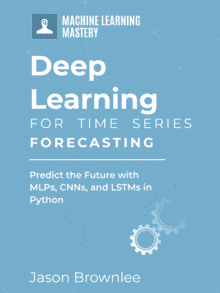
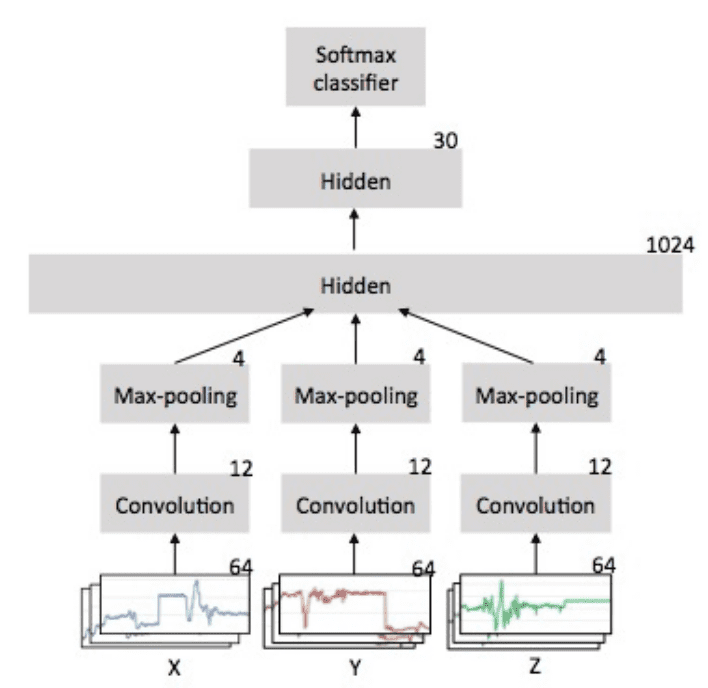
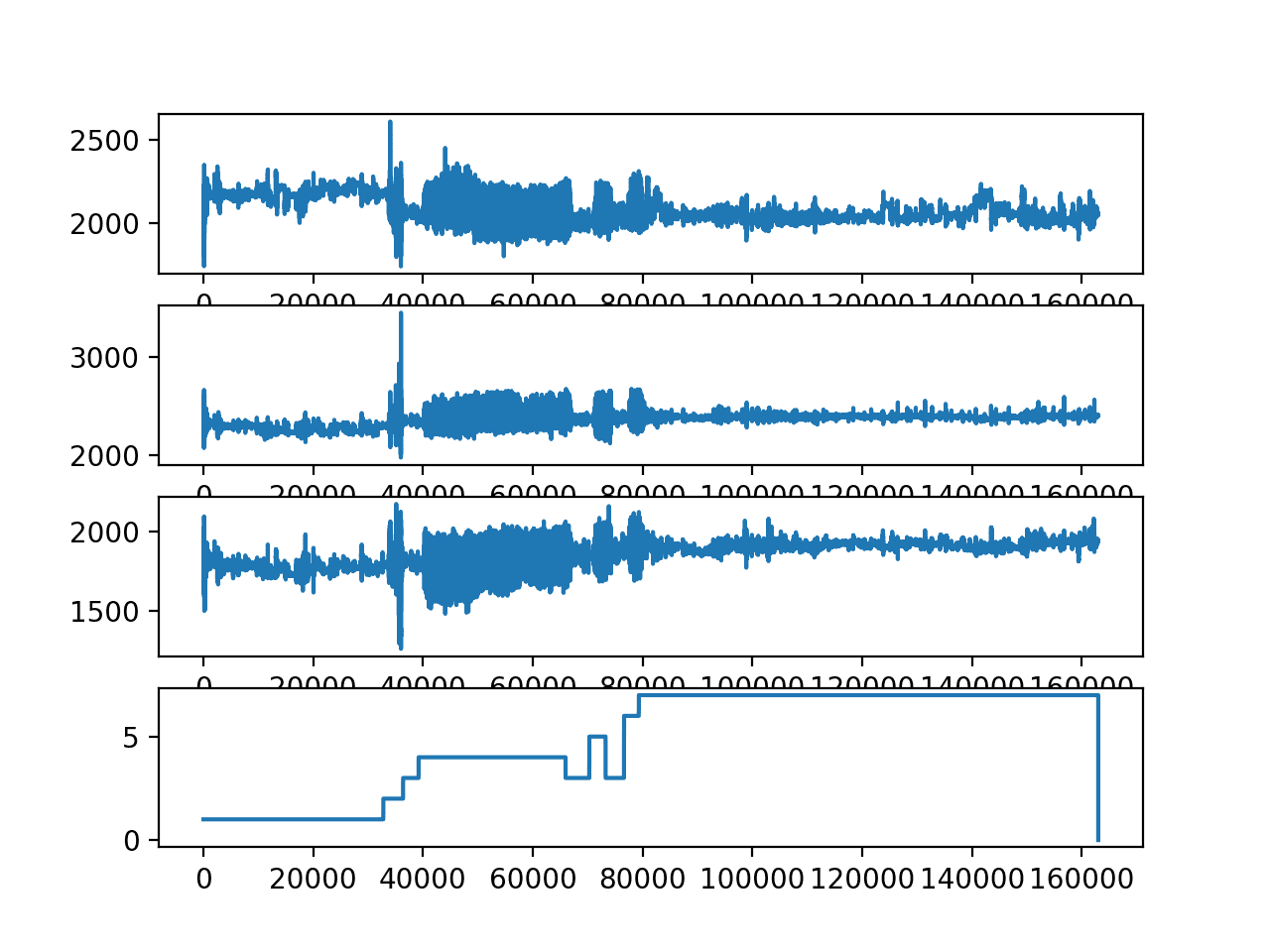
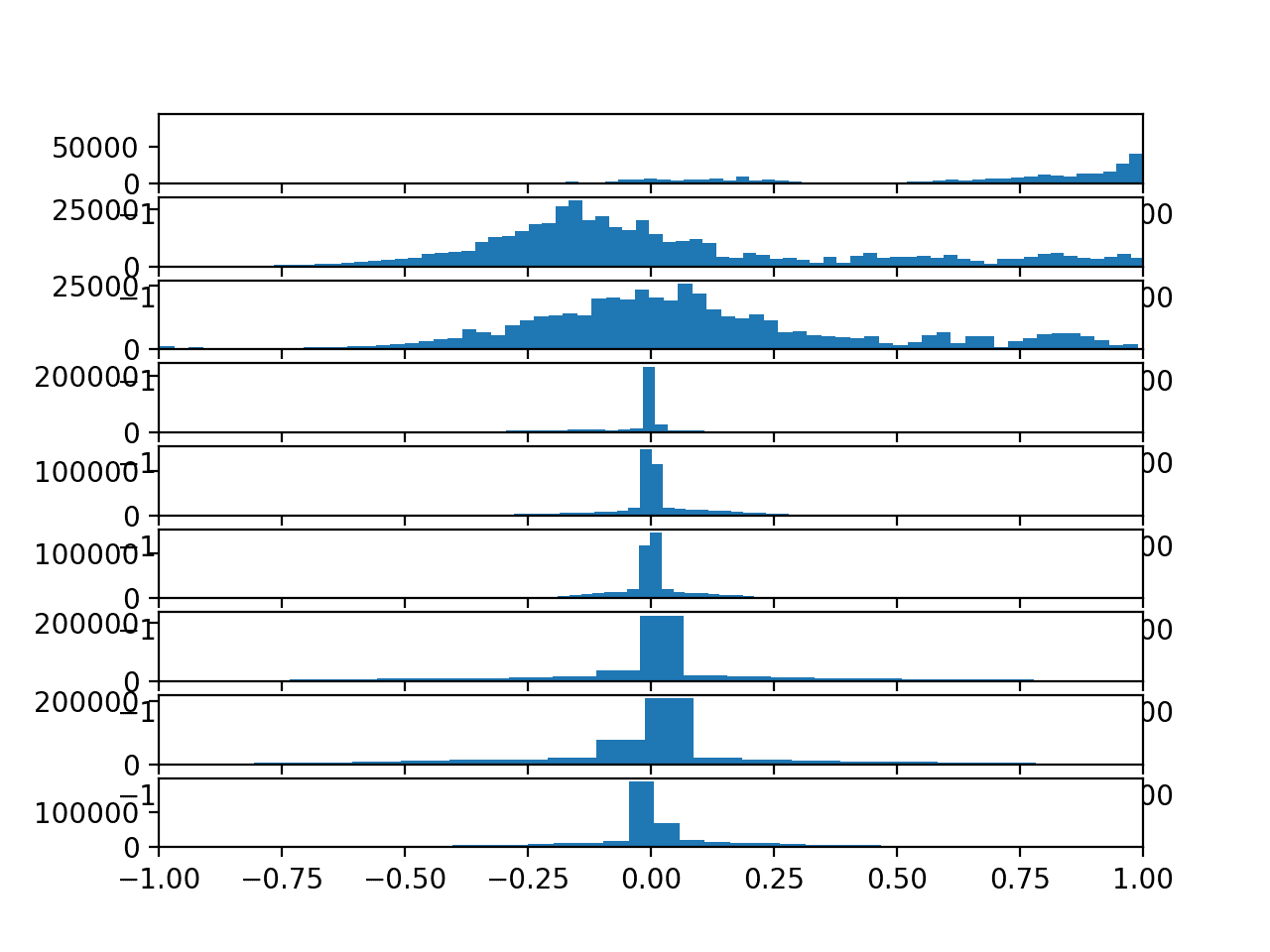


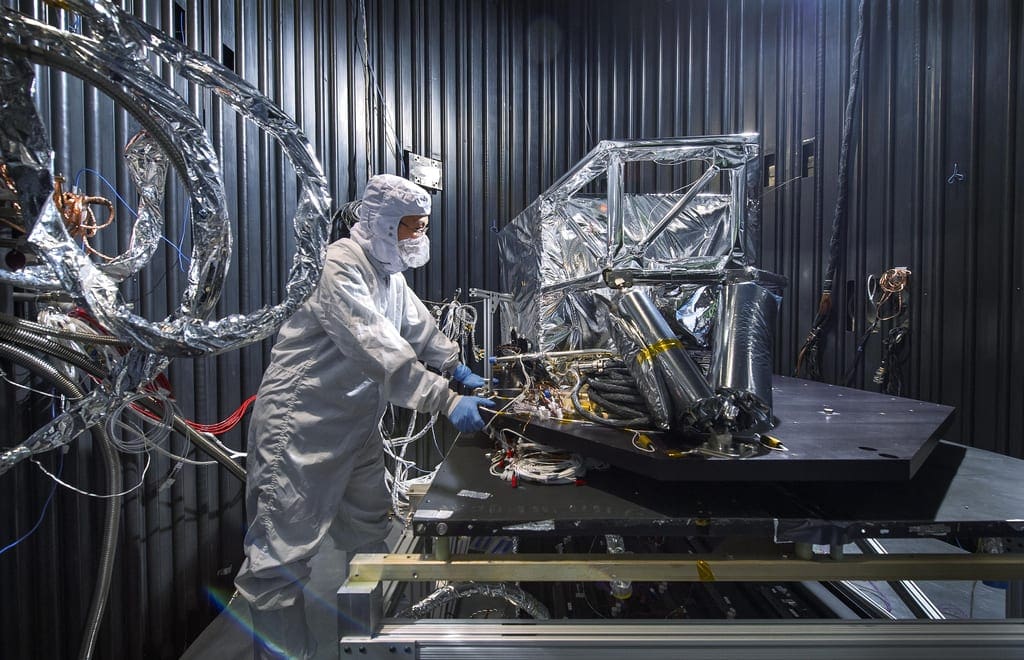
Hey awesome tutorial. For the raw model, is the reason why the scores are lower because:
It’s difficult to ‘stitch’ the data set back together to get it as close to the feature-engineered version as possible? Or are there other fundamental differences between the two?
Thanks!
I think feature engineering would greatly improve the results.
One thing i noticed about the raw files is that the features have been standardized. Is that pretty much the major difference?
No, more advanced methods from signal processing were used I believe.
Awesome tutorial!
Thanks.
can we do the same idea with Semi-supervised learning algorithms?
Perhaps.
Hi Sir,
why u have used Gaussian naive bayes here?
Isn’t it like we use Gaussian NB in case of regression type problems?
Also why NB giving so bad accuracy here? Any intution?
Gaussian naive bayes can be used for classification.
Perhaps the algorithm gives poor performance because it makes simplifying assumptions that are not helpful.
Hi Sir,
why ensemble tree based models have performed good over raw dataset?
We cannot know why, at least not easily.
This is something that ML algorithms are not good at answering – why some work well and some don’t for a given dataset.
“The specific results may vary each time the code is run, given the stochastic nature of the algorithms. Nevertheless, given the size of the dataset, the relative relationships between the algorithm’s performance should be reasonably stable.”
Sir how the ML models like knn, svm etc are stochastic?
here for ML models we are saying that they will be stable even running once but in deep earning models we ran the models several times. why is so? Is it because in deep learning models we are assigning more random parameter values initially like weights , batch size etc?
not all algorithms are stochastic, e.g. knn, but many are, e.g. ensembles of decision trees.
Hi, can i train a movement by using a video? e.g. push, pull, punch, open/close door?
I believe so, you you will require a different model. Sorry, I do not have a tutorial on this.
Hey I want to recognize human activity based on Kinetics Data set…
i want to create my own train model
Is there any helping source you have done???
help me i m beginner and i want to learn more.
Perhaps some of the tutorials here can be adapted for your dataset:
https://machinelearningmastery.com/start-here/#deep_learning_time_series
Can we use Logistic Regression?
Sure.
Thanks
You’re welcome.
Can we calculate precision and recall in this example
Yes, this will help:
https://machinelearningmastery.com/how-to-calculate-precision-recall-f1-and-more-for-deep-learning-models/
how did you have convert temporal data to discrete nature? Kindly explain it
Good question, perhaps start here:
https://machinelearningmastery.com/time-series-forecasting-supervised-learning/
Nice explained.
UCI HAR-Dataset is already pre-processed by the sliding window method, it means you can directly applying supervised learning models? Kindly correct me
But for LSTM, how did you have applied the same pre-processed data?
The LSTM example uses the raw data.
Please explain the features (are 9) and feature variables (are 561). How did you have used the same features in the ensemble, supervised algorithms, and in the LSTM?
Sorry, I don’t understand your question, what do you mean exactly?
According to the above statement (The result was a 561 element vector of features,
There are 128-time steps and nine features)
dear Jason how many features in this dataset have? can we say that features are 9?
This will help you understand the dataset:
https://machinelearningmastery.com/how-to-model-human-activity-from-smartphone-data/
I would like to know how they work in feature engineering was applied to the window data part, for instance, splitting data into fixed windows for 2.56 seconds.
thx a lot .
someone can help me .